Staying updated with industry trends is crucial in mobile app development. The mobile app developer is evolving, with technological advancements shaping the way applications are designed, developed, and experienced by users.
Aloa, an expert in software outsourcing, helps businesses and startups navigate these challenges by offering valuable insights into the latest trends and forecasts for mobile app development in 2024. With a focus on staying ahead of the curve, Aloa assists organizations in harnessing the potential of mobile app development to enhance user experiences and drive business growth.
In this blog, we provide a comprehensive overview of the top mobile app development trends for 2024. From emerging trends to industry statistics and forecasts, we delve into the key factors that will shape the mobile app development landscape. Afterward, you will clearly understand what to watch for when working with or hiring a mobile app developer in 2024, ensuring your business remains competitive in the rapidly changing world of mobile applications.
Stay tuned for valuable insights and actionable strategies to stay at the forefront of mobile app development. Let's dive in!
Top 8 Stats, Trends, and Forecasts When Hiring A Mobile App Developer In 2024
In 2024, hiring a mobile app developer is poised to be more competitive and dynamic than ever before. As the mobile app industry evolves, staying informed about these factors will be crucial for businesses and organizations looking to build cutting-edge mobile applications.
Here are the top 8 insights to consider when hiring a mobile app developer in 2024.
1. Cross-Platform Development
In 2024, Cross-Platform Development is one of the foremost trends to consider when hiring a mobile app developer. The need for cost-efficiency and broader market reach drives this approach. Cross-platform development allows developers to create apps that run seamlessly on multiple operating systems like iOS and Android, saving time and resources.
Developers have crafted several tools for cross-platform app development, with the top 5 popular frameworks being:
- Flutter (Google, 2017): Uses Dart for Android, iOS, Windows, macOS, Linux, and more; noted for versatility and performance (Google Pay, eBay).
- React Native (Meta, 2015): Supports mobile, desktop, smart TV, and VR (Facebook, Skype, Shopify, Microsoft Office).
- Apache Cordova: For Android, iOS, and Windows Phone; CSS, HTML, JavaScript with native WebView (formerly PhoneGap).
- Ionic: Hybrid apps on Android, iOS, and Universal Windows Platform; merges Sass, CSS, and HTML with native.
- Xamarin (Microsoft, 2016): Utilizes .NET, Visual Studio; cross-platform code reuse (Android, iOS, tvOS, watchOS, macOS, Universal Windows Platform).
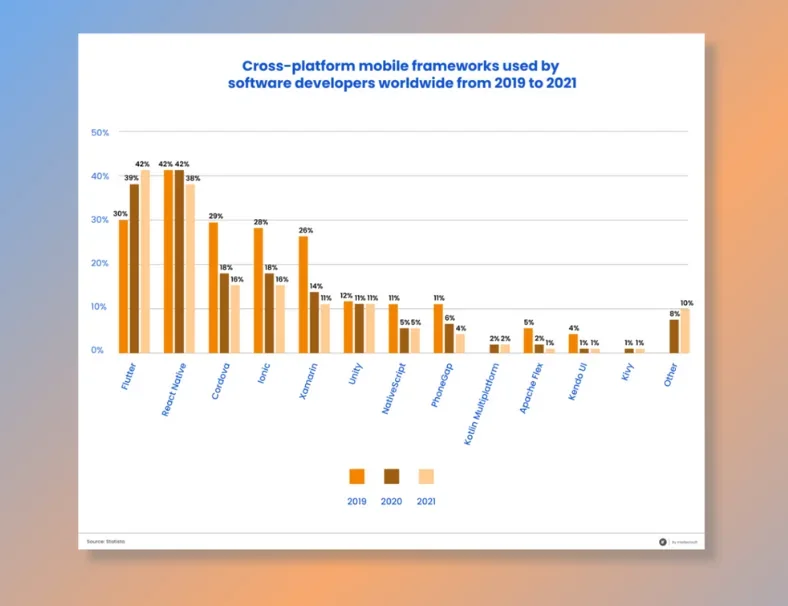
Considerations for Implementing Cross-Platform Development
- Tool Selection: When opting for cross-platform development, choose the right tools. Frameworks like Flutter and React Native offer versatility but require different skill sets.
- User Experience: Ensure the cross-platform app provides a consistent and high-quality user experience across all platforms. Customization may be needed to address platform-specific nuances.
- Performance Optimization: Performance can be a concern in cross-platform development. Developers should focus on optimizing app performance to deliver a snappy user experience.
- Security: Implement robust security measures as cross-platform apps may face unique vulnerabilities. Regular updates and security audits are crucial.
- Testing Strategy: Comprehensive testing across various devices and OS versions is vital. Consider using automated testing tools to streamline the process and catch potential issues early.
By carefully considering the factors above, you can ensure the successful implementation of this trend and the creation of apps that cater to a broader audience while optimizing development resources.
2. AI and ML Integration
In 2024, integrating Artificial Intelligence (AI) and Machine Learning (ML) into mobile app development is a critical trend to consider when hiring a mobile app developer. This trend is driven by the increasing demand for smart, data-driven applications that can provide personalized experiences and automate tasks.
As per the data below, funded startups and businesses predominantly favor AI and ML-powered mobile apps, in the coming three years, there's an anticipated doubling of organizations investing in Machine Learning.
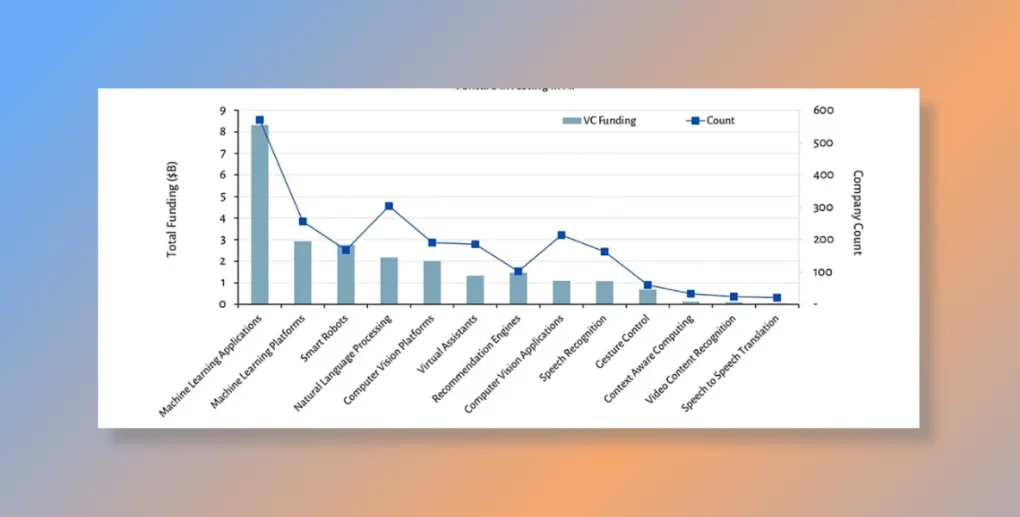
Considerations for Implementing AI and ML Integration
- Data Collection and Quality: Ensure access to high-quality data for training ML models. Data collection, storage, and preprocessing are crucial to creating compelling AI-powered features.
- Algorithm Selection: Choose suitable ML algorithms that align with the app's goals. For example, depending on the app's functionality, recommendation systems, natural language processing, or computer vision models may be relevant.
- Scalability: Plan for scalability as the app's user base grows. AI and ML models should be able to handle increased data volumes and computational demands without compromising performance.
- User Privacy and Data Security: Address user privacy concerns by implementing robust data protection measures. Comply with data privacy regulations and communicate transparently about data usage.
- Monitoring and Maintenance: Continuously monitor AI and ML models' performance and accuracy. Implement mechanisms for model retraining and updates to keep the app relevant.
Integrating AI and ML effectively allows a mobile app developer to create apps offering intelligent features, predictive capabilities, and enhanced user experiences. This trend keeps your app competitive and opens up new possibilities for innovation in the dynamic world of mobile app development in 2024.
3. 5G Integration
In 2024, one of the pivotal considerations for hiring a mobile app developer is the seamless integration of 5G technology. This trend is driven by the transformative potential of 5G networks, promising lightning-fast data speeds and ultra-low latency, revolutionizing the mobile development landscape.
In 2021, 5G constituted 8% of global mobile connections, with lower adoption in most regions. By 2025, 25% of mobile connections are projected to be on 5G networks, while 4G is anticipated to maintain a significant majority at 55%.

Considerations for Implementing 5G Integration
- Network Optimization: Leverage the full capabilities of 5G networks by optimizing your app's performance for high-speed data transfer. Prioritize content delivery and real-time updates.
- Enhanced User Experience: Utilize 5G's low latency to create immersive experiences, such as augmented reality (AR) and virtual reality (VR) features, catering to the evolving expectations of mobile users.
- Data Efficiency: Ensure your app consumes less data while delivering rich content. This is crucial, as faster connections lead to higher data consumption, affecting user costs and satisfaction.
- Security: As 5G enables more connected devices, prioritize robust security measures to protect sensitive user data and maintain trust.
- Global Reach: Consider the global deployment of 5G networks, adapting your app for users in various regions to ensure a consistent experience.
By focusing on 5G integration when hiring a mobile app developer, you can position your app at the forefront of technology, catering to the growing community of mobile users relying on high-speed networks through smartphones and tablets. This trend opens up exciting opportunities for creating innovative and data-intensive applications that harness the full potential of 5G technology.
4. AR and VR Integration
In 2024, integrating Augmented Reality (AR) and Virtual Reality (VR) technologies is a compelling trend to consider when hiring a mobile app developer. AR and VR transform how users engage with applications, offering immersive and interactive experiences. The growing demand for innovative and captivating applications in various industries, including gaming, education, healthcare, and beyond, drives this trend.
Although virtual and augmented reality are often hailed as the next major breakthroughs, there remains to be some clarity regarding their practical applications. Goldman Sachs forecasts the industry to be worth $80 billion annually by 2025, with $35 billion allocated to software and $45 billion to hardware. This underscores the vast and varied potential of AR/VR technology.

Considerations for Implementing AR and VR Integration
- Platform Selection: Choose the appropriate AR and VR integration platforms, such as ARKit and ARCore for augmented reality or Oculus and HTC Vive for virtual reality. Consider your target audience and the devices they are likely to use.
- Hardware Compatibility: Ensure that the app is optimized for the hardware it will run on, considering factors like sensors, cameras, and headsets.
- User Interface and Experience: Design an intuitive and immersive user interface. Consider how users interact with the AR or VR elements and provide a seamless experience.
- Performance Optimization: Optimize the app's performance to deliver smooth, responsive AR/VR experiences. This includes minimizing latency and maximizing frame rates.
- Content Creation: Invest in engaging AR/VR content that aligns with your app's purpose. This may involve 3D modeling, animations, and spatial mapping.
Integrating AR and VR into mobile apps can set your application apart in the competitive mobile app development landscape in 2024. Considering these factors, you can ensure that your app leverages these immersive technologies effectively and provides users with novel and captivating experiences.
5. IoT Integration
When considering hiring a mobile app developer in 2024, IoT (Internet of Things) integration is a trend that cannot be overlooked. IoT technology connects physical devices and objects to the digital world, offering opportunities for enhanced functionality and automation in mobile applications.
As per Statista's survey findings, the number of IoT-connected devices is projected to exceed 50 billion by 2023 and reach 75 billion by 2025, as illustrated in the accompanying figure.

Considerations for Implementing IoT Integration
- Hardware Compatibility: Ensure the mobile app developer has expertise in selecting and integrating IoT hardware components like sensors, actuators, and communication modules into the application.
- Data Handling: IoT generates vast amounts of data. Developers must design efficient data handling and storage mechanisms to process and analyze this data effectively.
- Security: IoT devices can be vulnerable to cyberattacks. Robust security measures, such as encryption and authentication, must be implemented to safeguard both the devices and the data they transmit.
- Real-Time Communication: IoT applications often require real-time communication between devices and the app. Consider the use of messaging protocols and APIs to enable seamless communication.
- Scalability: Plan for scalability, as IoT ecosystems can proliferate. Ensure that the app can accommodate additional devices and data streams without performance degradation.
Integrating IoT into mobile apps allows developers to create innovative solutions that bridge the physical and digital worlds. This trend opens up new possibilities for applications in fields such as home automation, healthcare, agriculture, and more, making IoT integration a vital consideration in 2024.
6. Voice and Chatbot Interfaces
In 2024, integrating Voice and Chatbot Interfaces is a pivotal trend to explore when considering hiring a mobile app developer. The growing user preference for conversational and hands-free interactions with mobile apps drives this trend.
The survey indicates that customers have certain expectations:
- They anticipate swift responses at all hours, any day of the week.
- They desire a way to reach out to a human agent, especially for sharing negative experiences or addressing issues with a product or service.
However, it's worth noting that most consumers are impatient and open to using chatbots. A positive chatbot experience typically revolves around obtaining precise answers to straightforward inquiries.

Considerations for Implementing Voice and Chatbot Interfaces
- User-Centric Design: Prioritize user experience in voice and chatbot interfaces. Understand user needs and preferences to create intuitive, conversational interactions.
- Natural Language Processing (NLP): Leverage NLP technology for chatbots to understand and respond to user queries more effectively. Keep updating the chatbot's knowledge base to improve its performance over time.
- Voice Recognition Accuracy: Ensure high accuracy in voice recognition systems to enhance the user's trust and satisfaction. Invest in robust voice recognition software and continuous improvement.
- Multilingual Support: If your app has a global audience, consider providing multilingual support for voice and chatbot interactions to cater to a diverse user base.
- Data Privacy: Address data privacy concerns related to voice and chatbot interactions. Implement encryption, secure data storage, and inform users about data usage.
By effectively integrating Voice and Chatbot Interfaces, a mobile app developer can create apps that offer users a more natural and convenient way to interact with technology. This trend aligns with the increasing demand for seamless communication and automation in mobile apps, making it a crucial consideration for developers in 2024.
7. Low-Code/No-Code Development
Low-code/No-Code development is a significant trend in 2024 that anyone looking to hire a mobile app developer should pay attention to. This approach is driven by the increasing demand for faster app development and the need to empower non-technical professionals to create applications.
Low-code aims to enhance the productivity and quality of practitioners, including application developers, engineers, data scientists, and system administrators. It achieves this by offering tools and higher-level abstractions instead of traditional software development languages and tools. This often includes a drag-and-drop interface for creating data pipelines, mobile user interfaces, workflows, integrations, or data visualizations.
Customization options can involve coding paradigms, like using native JavaScript, Java, or other languages, or leveraging proprietary scripting and meta-language capabilities for customization and configuration within the platform.
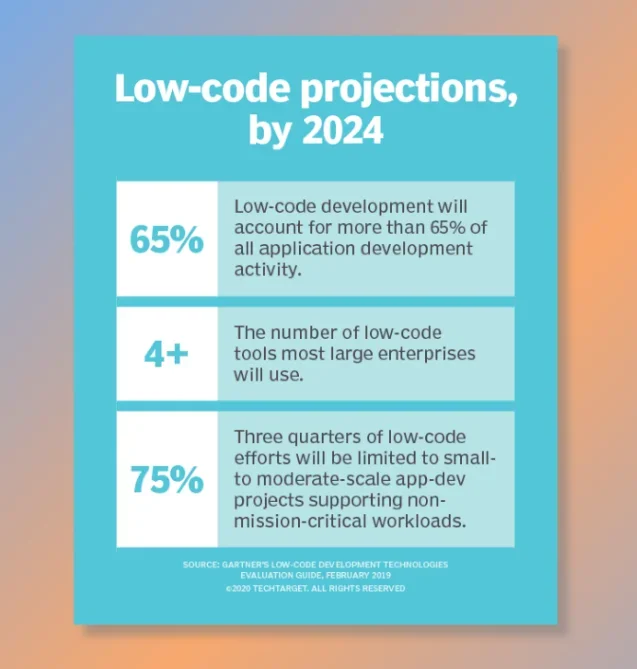
Considerations for Implementing Low-Code/No-Code Development
- User-Friendly Interface: Ensure the chosen Low-Code/No-Code platform offers an intuitive and user-friendly interface. The goal is to enable individuals with limited coding experience to build functional apps.
- Scalability: Evaluate the scalability of the chosen platform. Confirm that it can accommodate the growth of your app and handle complex projects if necessary.
- Integration Capabilities: Check if the platform allows seamless integration with other systems and services. Integration is essential for creating robust and interconnected applications.
- Security Measures: Prioritize security when using Low-Code/No-Code tools. Ensure the platform has built-in security features and complies with relevant data protection regulations.
- Customization Flexibility: While Low-Code/No-Code platforms are user-friendly, they should also offer a degree of customization to meet unique business requirements.
In 2024, Low-Code/No-Code development is revolutionizing the app development landscape, making it accessible to a broader audience. When considering this trend while hiring a mobile app developer, focus on selecting the right platform that aligns with your project's needs and ensures that security and scalability are not compromised during development.
8. Remote Work Tools
Remote work tools have become a pivotal aspect of the mobile app developer hiring landscape in 2024. The mobile application developer job market has transcended geographical boundaries, driven by various factors, such as the global shift towards remote work and the increasing demand for innovative digital solutions.
In 2020, a global survey found that about 54% of respondents reported improved collaboration with colleagues in project management due to remote work. This enhanced collaboration extended beyond departments and positions, playing a crucial role in supporting DevOps and agile methodologies.
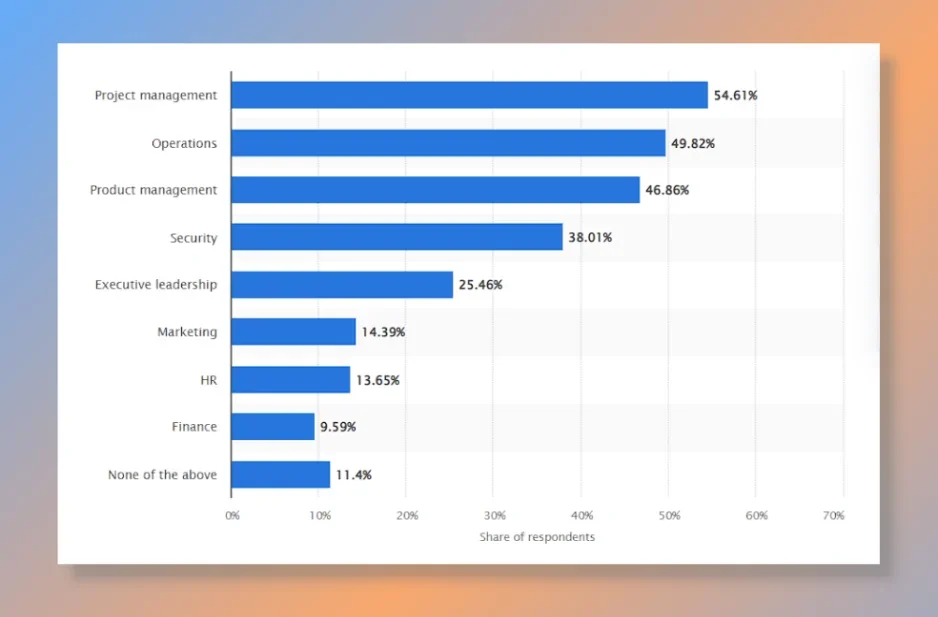
Considerations for Implementing Remote Work Tools
- Collaborative Platforms: Mobile developers need access to robust collaborative platforms to work seamlessly with remote teams—tools like Slack, Microsoft Teams, and Zoom foster real-time communication and project coordination.
- Cloud Development Environments: With the rise of remote work, cloud-based development environments like AWS Cloud9 and Google Cloud Platform are indispensable. They enable mobile application developers to access resources and collaborate from anywhere.
- Code Repositories: Utilizing version control systems like Git and platforms like GitHub or Bitbucket is crucial for efficient code management and collaboration among mobile application developers.
- Project Management Tools: Implementing project management tools like Trello, Asana, or Jira streamlines task assignments, progress tracking, and project planning, enhancing productivity.
- Security Measures: Ensuring the security of remote work tools is paramount. Mobile application developers must use VPNs, encryption tools, and multi-factor authentication to safeguard sensitive data and code repositories.
Adapting to the remote work environment and integrating the right tools is essential to attract top talent and foster productive, collaborative development teams. A mobile app developer well-equipped with these tools is better positioned to succeed in a competitive and fast-evolving industry.
How to Stay Ahead of the Curve on Mobile App Development Trends
In 2024, the demand for skilled mobile application developers continues to soar, making it crucial for those in the field to keep up with the latest trends and developments. Here are five key strategies to stay at the forefront of the ever-evolving mobile app development landscape.
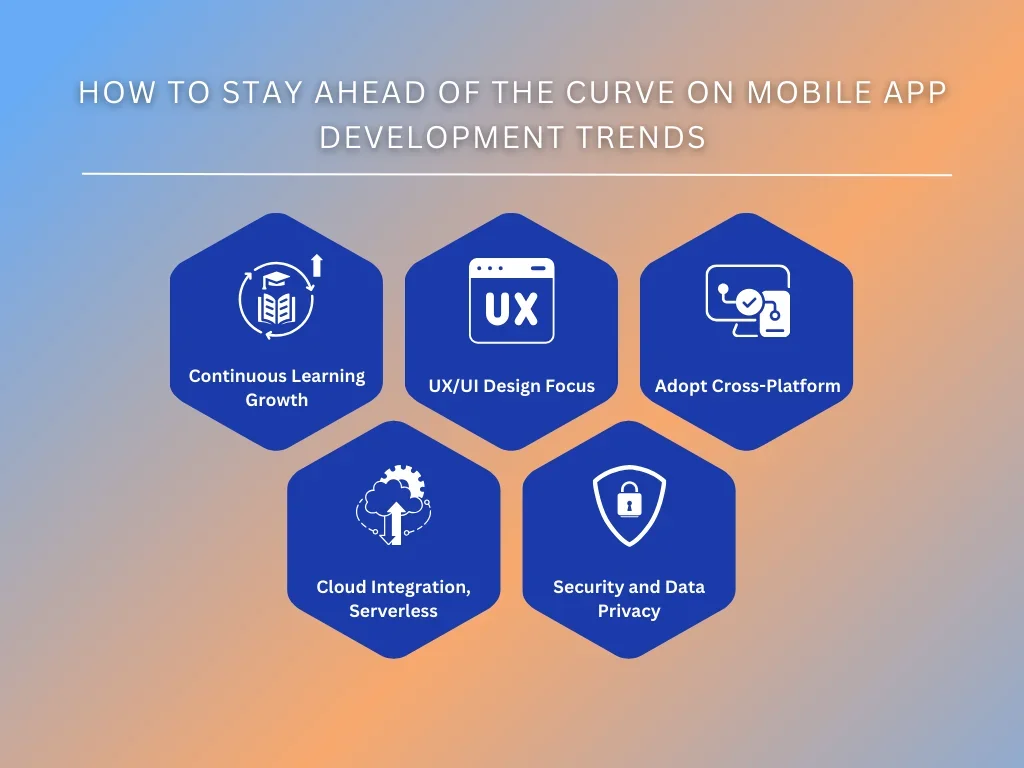
Continuous Learning and Skill Enhancement
The world of software development is dynamic, with new tools, languages, and frameworks emerging regularly. Mobile application developers must commit to continuous learning to remain relevant. Enroll in online courses, attend workshops, and earn certifications to stay up-to-date with the latest technologies in mobile application development. Whether mastering new programming languages like Swift for iOS app development or diving into emerging technologies like GraphQL, a commitment to learning is essential.
Focus on User Experience (UX) and User Interface (UI) Design
As mobile developers, creating an exceptional user experience is paramount. User expectations continue to rise, and apps with intuitive interfaces and smooth functionality stand out. Pay close attention to UI/UX design, ensuring your apps are visually appealing and easy to navigate. Stay informed about the latest trends in UI design, such as dark mode, minimalistic interfaces, and responsive design, to provide the best user experience possible.
Embrace Cross-Platform Development
While native development for iOS and Android has advantages, the demand for cross-platform development is rising. Tools like React Native and Flutter allow mobile application developers to write code once and deploy it across multiple platforms, reducing development time and costs. As mobile platforms evolve, mastering cross-platform development will be a valuable skill.
Cloud Integration and Serverless Computing
In 2024, integrating cloud services and serverless computing in mobile apps is a growing trend. Mobile apps increasingly rely on cloud infrastructure for storage, data processing, and scalability. Familiarize yourself with cloud platforms like AWS, Azure, and Google Cloud, as well as serverless technologies. This knowledge will enable you to build robust, scalable apps that can handle the demands of a large user base.
Security and Data Privacy
With the increasing reliance on mobile apps for everything from healthcare to finance, security, and data privacy have never been more critical. Stay informed about the latest security threats and best practices for securing mobile applications. Understand the principles of encryption, secure authentication methods, and data protection regulations like GDPR and HIPAA. Building apps with high security and data privacy standards will be essential to earning user trust and compliance with legal requirements.
Key Takeaway
In 2024, understanding the significance of stats, trends, and forecasts when hiring a mobile app developer is crucial for businesses aiming to thrive in the ever-competitive mobile app landscape. As the demand for mobile application developers continues to surge, startups and established businesses have reaped substantial benefits from having top-notch mobile app development talent on their teams.
Startups, in particular, have leveraged the expertise of mobile application developers to catapult their digital presence. With consumers increasingly relying on mobile devices and app stores, businesses have recognized the need to optimize their mobile applications for seamless user experiences.
Hiring app developers with software engineering, Java, JavaScript, and database management expertise is paramount to meeting these high standards. As the industry evolves, hybrid app development, game design, and web development remain pivotal focus areas for mobile application developers.
In 2024, contact [email protected] to connect with an exceptional mobile app developer who can drive your business to new heights. Take advantage of the opportunity to tap into this thriving career path and make your mark in mobile app development.

